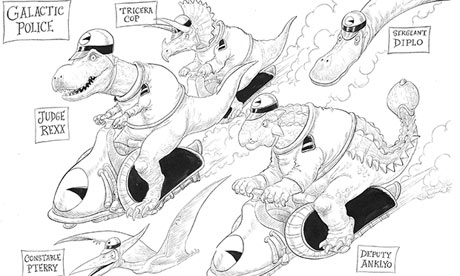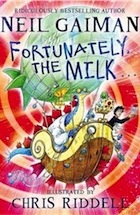 |
| Neil Gaiman |
Fortunately, the Milk by Neil Gaiman – review
Gaiman's inventive tale of time travel relies on Chris Riddell's illustrations to flesh out the fun


High comedy … a detail of Chris Riddell’s illustration of dinosaur galactic police on space bikes in Fortunately, the Milk. Click to enlarge
Neil Gaiman is a phenomenon. I'm not saying that's good. I'm not saying that's bad. I'm simply stating a fact. As @neilhimself he has more than 1.8 million followers on Twitter, with a cult following both online and in the flesh. A fellow author recently commented that when Gaiman talks, people clap. When he coughs, they laugh. He inspires loyalty like few others. There is, in effect, the cult of Gaiman.
Probably best known for his adult novels, comics and films, Gaiman isn't one of those writers who occasionally "dabbles" in children'sfiction. Coraline (2002), an eerie tale in which a parallel mother seems more loving than the protagonist's actual parent but has sewn-on button eyes, is an original and exciting piece of storytelling; The Wolves in the Walls (2003) is as nightmarish as the title suggests; The Graveyard Book (2008), in which an orphaned boy is adopted by the graveyard's inhabitants, won both the Carnegie medal in the UK and the Newbery medal in the US. Gaiman is not only a "ridiculously bestselling author", as it says on the cover of Fortunately, the Milk, but he also writes wildly inventive and exciting children's fiction.

Before all of these, in 1997, came The Day I Swapped My Dad for Two Goldfish, which, likeThe Wolves in the Walls, was illustrated by Dave McKean. It tells how a dad is swapped from one child to the next, blissfully unaware of his fate because he is too busy reading the paper.
And now a dad is back, centre stage, in Fortunately, the Milk. Though heralded as a new Gaiman book, this is also very much a Chris Riddell production. When Gaiman was nominated for the Carnegie forThe Graveyard Book, its illustrations, also by Riddell, were nominated for the Kate Greenaway medal, the first time such a double nomination had occurred. In Fortunately, the Milk, Riddell's contribution is greater still.

So what's the story? Simple: Dad goes out to get some milk for his kids, taking ages but eventually returning with a carton. When asked why he took so long, he tells them a fantastical tale involving a spaceship of green globby aliens (who believe that plastic flamingos are the highest art form on Earth; Splod (the god of people with short funny names); brightly coloured ponies; vampires (or wumpires as they call themselves, with their strong accents); dinosaur galactic police on space bikes; and – most important by far – Professor Steg, the time-travelling stegosaurus. Professor Steg is the kind of being who calls a spade a spade or, to be more specific, calls a floaty-ball-person-carrier a Floaty-Ball-Person-Carrier (though we might think of it as a hot air balloon). And, coming from around 150m years in our past, he has every right to name things his way, because he got there first.
Then there are the fears of what might happen if Dad's carton of milk from one time were to touch Dad's carton of milk from another (they are, of course, really one and the same carton). This is a story in which much silliness ensues.
But it is incredibly slight. Of course it's funny and inventive – this is Gaiman we're talking about – but without the extremely generous number of detailed illustrations, Fortunately, the Milk would be a mighty thin book and the story thinner still. This is a fun conceit which Chris Riddell has fleshed out and done his darnedest to buff to a shine. The eagle-eyed reader will spot that many toys, books and pictures around the house have miraculously become part of Dad's explanation for being late, in much the way that Kevin Spacey's character spins a yarn using elements of what's around him in The Usual Suspects. (Gaiman lays the seeds for this in the text by having My-Little-Pony-esque horses put in an appearance.)
Had Gaiman not been the author of this story, would it have been lavished with such illustrations and high production values? Of course not. And what of the young readers who come to the book knowing nothing of Gaiman or how he came to write it? What of the young readers who don't know that Chris Riddell has drawn Dad to look like a younger Neil himself? For many of these, I suspect, the book won't fully engage and satisfy as a standalone story in its own right.
Although pitched as a children's book, this latest work doesn't connect in the way that his previous children's titles do, and not simply because it's high comedy. But for dads and older, existing Gaiman fans? Fortunately,The Milk is very likely to be just their cup of tea.
• Philip Ardagh's The Grunts in Trouble and The Grunts All at Sea are published by Nosy Crow.



No comments:
Post a Comment